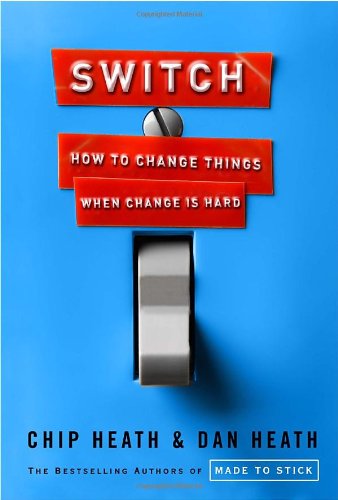
Why is it so hard to make lasting changes in our companies, in our communities, and in our own lives?
The primary obstacle is a conflict that’s built into our brains, say Chip and Dan Heath, authors of the critically acclaimed bestseller Made to Stick. Psychologists have discovered that our minds are ruled by two different systems—the rational mind and the emotional mind—that compete for control. The rational mind wants a great beach body; the emotional mind wants that Oreo cookie. The rational mind wants to change something at work; the emotional mind loves the comfort of the existing routine. This tension can doom a change effort—but if it is overcome, change can come quickly.
In Switch, the Heaths show how everyday people—employees and managers, parents and nurses—have united both minds and, as a result, achieved dramatic results:
● The lowly medical interns who managed to defeat an entrenched, decades-old medical practice that was endangering patients.
● The home-organizing guru who developed a simple technique for overcoming the dread of housekeeping.
● The manager who transformed a lackadaisical customer-support team into service zealots by removing a standard tool of customer service
In a compelling, story-driven narrative, the Heaths bring together decades of counterintuitive research in psychology, sociology, and other fields to shed new light on how we can effect transformative change. Switch shows that successful changes follow a pattern, a pattern you can use to make the changes that matter to you, whether your interest is in changing the world or changing your waistline.Chip Heath and Dan Heath on Switch: How to Change Things When Change Is Hard

“Change is hard.” “People hate change.” Those were two of the most common quotes we heard when we began to study change.
But it occurred to us that if people hate change, they have a funny way of showing it. Every iPhone sold serves as counter-evidence. So does every text message sent, every corporate merger finalized, every aluminum can recycled. And we haven’t even mentioned the biggest changes: Getting married. Having kids. (If people hate change, then having a kid is an awfully dumb decision.)
It puzzled us–why do some huge changes, like marriage, come joyously, while some trivial changes, like submitting an expense report on time, meet fierce resistance?
We found the answer in the research of some brilliant psychologists who’d discovered that people have two separate “systems” in their brains—a rational system and an emotional system. The rational system is a thoughtful, logical planner. The emotional system is, well, emotional—and impulsive and instinctual.
When these two systems are in alignment, change can come quickly and easily (as when a dreamy-eyed couple gets married). When they’re not, change can be grueling (as anyone who has struggled with a diet can attest).
In those situations where change is hard, is it possible to align the two systems? Is it possible to overcome our internal “schizophrenia” about change? We believe it is.
In our research, we studied people trying to make difficult changes: People fighting to lose weight and keep it off. Managers trying to overhaul an entrenched bureaucracy. Activists combatting seemingly intractable problems such as child malnutrition. They succeeded–and, to our surprise, we found striking similarities in the strategies they used. They seemed to share a similar game plan. We wanted, in Switch, to make that game plan available to everyone, in hopes that we could show people how to make the hard changes in life a little bit easier. –Chip and Dan Heath
(Photo © Amy Surdacki)

On the whole, a worthwhile, rewarding read… “Switch” oscillates between the citation of psychological research and the slightly-suspect relaying of ‘inspirational anecdotes’ (as is de rigeur for this genre), but is, on the whole, a worthwhile read. Coming across as a self-help version of , the authors wield an array of techniques to help people create change in their lives as painlessly as possible. In doing so, they indirectly provide an evidential basis for…
Switching “On” Your Emotional Intelligence Switch is a compelling, story-driven narrative the Heaths use to bring together decades of counterintuitive research in psychology, sociology, and other fields to shed new light on how we can engage our emotions and reason to create real change.The book is arranged around an analogy that illustrates the crux of emotional intelligence: when making a decision we are typically torn between our rational, logical reasons and our emotional, intuitive feelings. Chip and Dan ask us to…
Several sticky insights Chip and Dan Heath have once again summoned a lively writing style to present a series of compelling insights that make this book even more interesting as well as more valuable than its predecessor, Made to Stick. As they explain in the first chapter, “In this book, we argue that successful changes share a common pattern. They require the leader of change to do three things at once: To change someone’s behavior, you’ve got to change that person’s situation…[to cope with the fact that change]…